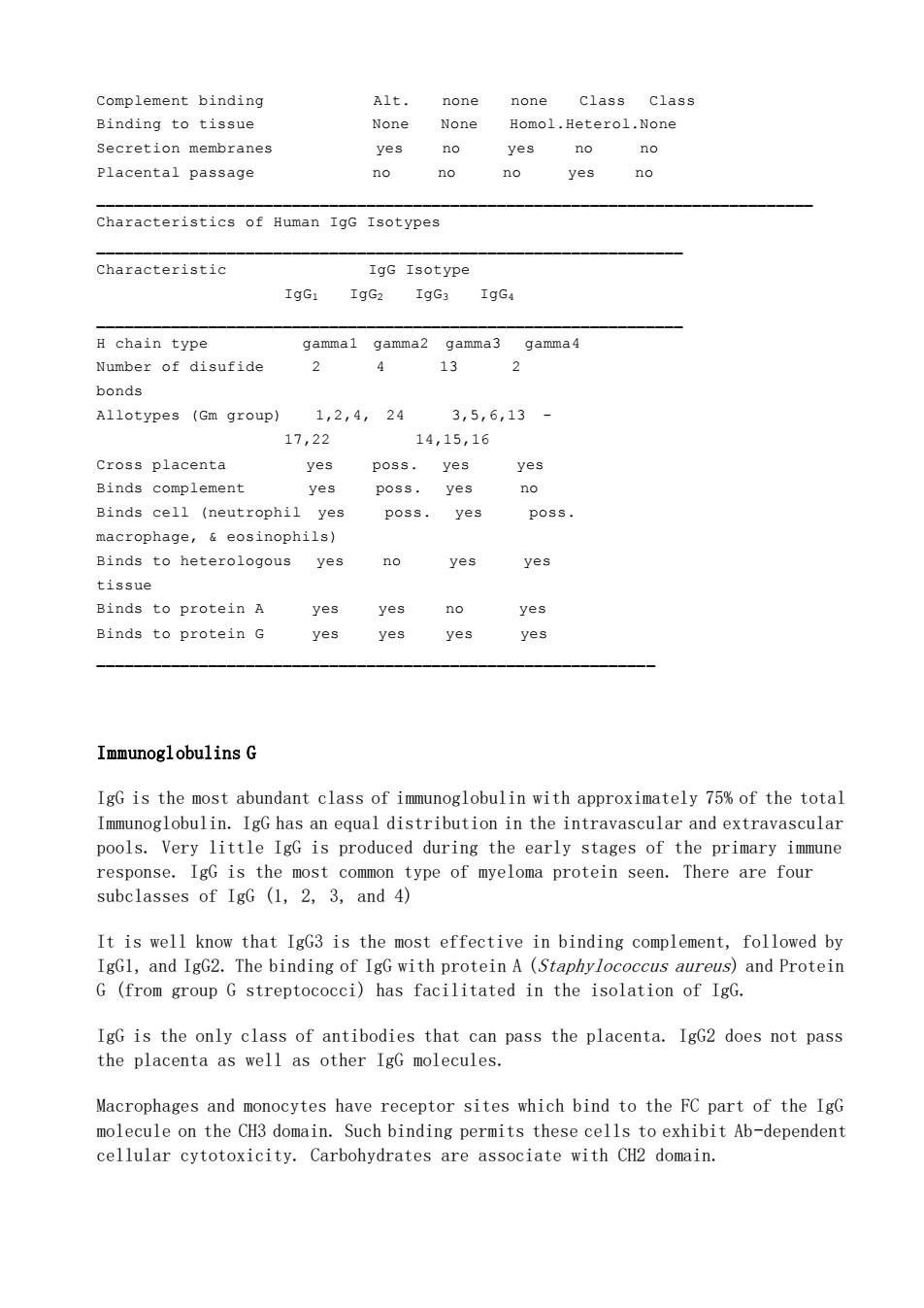正在加载图片...

Complement binding Alt. none none class class Binding to tissue None None Homol.Heterol.None Secretion membranes s no ves no no Placental passage no no no yes no Characteristics of Human IgG Isotypes Characteristic IgG Isotype IgG: H chain type gammal gamma2 gamma3 gamma4 Number of disufide 2 4 13 2 bonds Allotypes (Gm group) 1,2,4,24 3,5,6,13- 17,22 14,15,16 Cross placenta yes poss.yes yes Binds complement yes poss.yes no Binds cell (neutrophil yes poss.yes macrophage,eosinophils) Binds to heterologous yes no yes yes tissue Binds to protein A yes yes no yes Binds to protein G yes yes yes yes Immunoglobulins G IgG is the most abundant class of immunoglobulin with approximately 75%of the total Immunoglobulin.IgG has an equal distribution in the intravascular and extravascular pools.Very little IgG is produced during the early stages of the primary immune response.IgG is the common type of myeloma protein seen.There are four subclasses of IgG (1,2.3,and 4) It is well know that IgG3 is the most effective in binding complement,followed by IgGl,and IgG2.The binding of IgG with protein A (Staphylococcus aureus)and Protein G(from group G streptococci)has facilitated in the isolation of IgG. IgG is the only class of antibodies that can pass the placenta.IgG2 does not pass the placenta as well as other IgG molecules. Macrophages and monocytes have receptor sites which bind to the FC part of the IgG molecule on the CH3 domain.Such binding permits these cells to exhibit Ab-dependent cellular cytotoxicity.Carbohydrates are associate with CH2 domain. Complement binding Alt. none none Class Class Binding to tissue None None Homol.Heterol.None Secretion membranes yes no yes no no Placental passage no no no yes no _____________________________________________________________________________ Characteristics of Human IgG Isotypes _______________________________________________________________ Characteristic IgG Isotype IgG1 IgG2 IgG3 IgG4 _______________________________________________________________ H chain type gamma1 gamma2 gamma3 gamma4 Number of disufide 2 4 13 2 bonds Allotypes (Gm group) 1,2,4, 24 3,5,6,13 - 17,22 14,15,16 Cross placenta yes poss. yes yes Binds complement yes poss. yes no Binds cell (neutrophil yes poss. yes poss. macrophage, & eosinophils) Binds to heterologous yes no yes yes tissue Binds to protein A yes yes no yes Binds to protein G yes yes yes yes ____________________________________________________________ Immunoglobulins G IgG is the most abundant class of immunoglobulin with approximately 75% of the total Immunoglobulin. IgG has an equal distribution in the intravascular and extravascular pools. Very little IgG is produced during the early stages of the primary immune response. IgG is the most common type of myeloma protein seen. There are four subclasses of IgG (1, 2, 3, and 4) It is well know that IgG3 is the most effective in binding complement, followed by IgG1, and IgG2. The binding of IgG with protein A (Staphylococcus aureus) and Protein G (from group G streptococci) has facilitated in the isolation of IgG. IgG is the only class of antibodies that can pass the placenta. IgG2 does not pass the placenta as well as other IgG molecules. Macrophages and monocytes have receptor sites which bind to the FC part of the IgG molecule on the CH3 domain. Such binding permits these cells to exhibit Ab-dependent cellular cytotoxicity. Carbohydrates are associate with CH2 domain